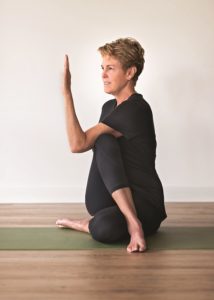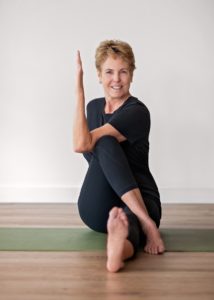It turns out that our bodies need a spring cleaning just like our homes do. Have you noticed feeling sluggish or stiff as spring comes on? In the winter, we spend more time indoors and probably get less exercise. We eat heavier foods, get less sunshine and fresh air. This all can lead to a sort of heaviness in the body.
Yoga has a fix for this: twisting poses. The seated spinal twist is a fundamental example. It’s a great way to sweep out the body’s cobwebs. (If you have osteoarthritis, however, this twisting of the spine may not be recommended for you. Ask your doctor.)
Classical yoga poses have Sanskrit names that reference their inner meanings and are known as asanas. They may describe the pose’s shape or function; some names recall Indian gods, sages, animals, or birds. The seated spinal twist is called ardha matsyendrasana, “Half Lord of the Fishes Pose.”
To set up for the seated spinal twist, place a mat or blanket down on the floor for some cushioning. Sit cross-legged with your right leg in front. If it is difficult to sit cross-legged, you may keep your left leg straight and cross your right leg over it.
Press down through the seat of your pants to make good contact with the floor. Place your hands on either side of your rib cage and lift it up and away from your hips. Feel yourself getting taller. Lengthen through the center of the top of your head, the crown, and relax your shoulders and jaw.
Now bring the sole of the right foot to the floor outside the left knee. Place your foot flat on the floor. Bring the sole of the left heel to touch the right hip so the left thigh is facing straight out from the torso (see first photo).

Here again, if having the left leg bent like this is too uncomfortable, you may straighten the leg (see second photo).

Interlock your hands around your shin and pull your torso upwards. Tuck your lower ribs in slightly and engage your core by drawing the muscles three inches below your navel in and up gently.
Cross the left elbow to the right side of the left knee and rest it there, elbow bent, forearm and hand pointed to the ceiling. Your right hand goes on the floor behind you — or on a block or blanket if your arm doesn’t reach the floor.
Are you breathing?
The first few times I did this pose, it brought to mind memories of people saying that in yoga it seems like you turn your body into a pretzel — this pose does look like one. It felt awkward. I had trouble breathing in the pose and everything felt crunched. It is harder to breath in a twist because your organs are twisted, lungs included.
My wise teacher at the time told me to lengthen through the spine and turn slowly from the waist, then the ribs, the chest, shoulders, the neck, and, last, the head and eyes. I had been racing forward with my head and eyes first and then bringing the rest of the body into the pose. It felt much better to work from the waist up.
I also found it important to relax as I approached the pose. My tendency was to tense my muscles and force my way into it. I found if I relaxed and thought of a wave motion, inhaling while lengthening the spine, exhaling while deepening the twist, I could flow into it with more ease and continue to breath easily. Let the breath be gentle.
Long slow breath in and long slow breath out. The breath is not meant to be forced but should flow comfortably.
After a few breaths on one side, repeat the pose on the other side.
To come out of the pose, move slowly.
As your body makes this wrapping motion around itself, your organs are stimulated. You might imagine them being squeezed like a sponge when you twist it to wring it out, and then released, with fresh new energy coming in. The pose can bring relief from backaches and sluggishness. It can improve digestion and help the spine to be more flexible and the hips more mobile.
It is a pose that can help us re-emerge from winter and begin to feel light again. A pose that’s perfect for May.
Jen Shannon is a Kripalu-certified yoga teacher who lives in Truro.



